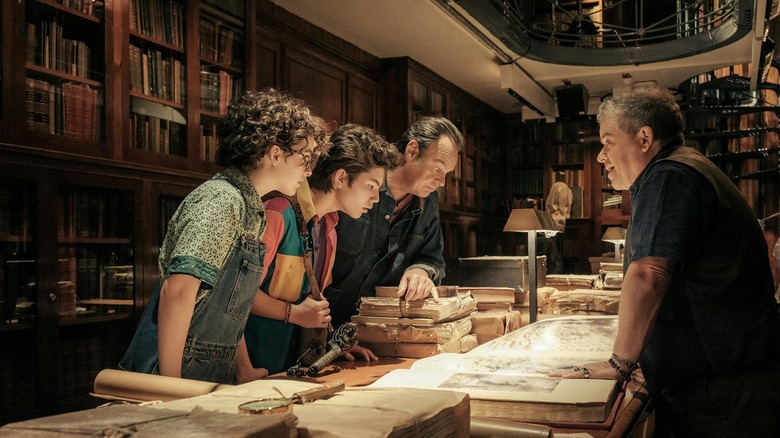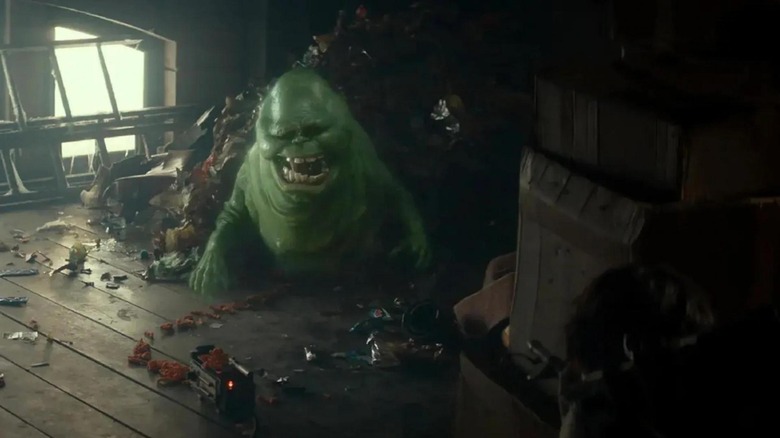Ghostbusters: Frozen Empire Proves The Franchise Has Limited Box Office Potential
It was a bit of a good news, bad news situation for Sony Pictures over the weekend. The good news is that "Ghostbusters: Frozen Empire," the latest entry in the long-running comedy/horror franchise, topped the box office with a $45 million haul. That was at the high end of expectations, which was certainly positive, and theaters could use the help right now. At the same time, the movie carries a $100 million budget — which was quite a bit higher than 2021's "Ghostbusters: Afterlife." And yet, at the end of the day, both movies opened to just about the same number domestically. This provides proof that this franchise has a pretty well-defined ceiling commercially, which likely limits what can be done going forward.
What's interesting is that the last three movies in the series all opened in an eerily similar range. 2016's female-led "Ghostbusters: Answer the Call" took in $46 million on its opening weekend en route to a $229 million global finish. 2021's "Afterlife," which was more akin to a proper "Ghostbusters 3," opened to $44 million on its way to $203 million worldwide. And here we are again in 2024 with "Frozen Empire" pulling in a nearly identical figure. While the jury is still out on the latest film's long-term prospects, it's also worth pointing out that these films have always had somewhat limited potential overseas. To that end, it opened with just over $16 million internationally, suggesting it will probably have a very similar trajectory to "Afterlife."
Therein lies the rub for Sony. With so-so reviews for "Frozen Empire" (read /Film's official review right here) it could have been so much worse. Yet, when merchandise and other revenue streams are factored in, the movie should still end up doing fine in the long run, even though it's more than likely going to wind up in a similar range as its predecessor. The difference is that "Afterlife" had a $75 million budget, which allowed it to be a success at $200 million worldwide.
The limits of the Ghostbusters franchise
The same can't be said for a movie with a $100 million budget, but that's what the latest sequel in the franchise is saddled with. Director Gil Kenan went bigger on "Frozen Empire," but that hasn't resulted in a better turnout at the box office. Sony is now in a situation where they are almost certainly going to lose money on the film in its theatrical run, relying on post-theatrical revenue to make up the difference. Granted, it's not nearly as financially dire as director Paul Feig's "Ghostbusters" in 2016, as that film had a whopping $144 million budget that straight-up doomed it commercially. Had the budget been smaller, we might be looking at a totally different version of this franchise right now.
At the very least, Sony learned its lesson and kept the budget much lower for "Afterlife." The studio knows they can't budget these like Marvel movies anymore. But it's been clear for a very long time that the studio has wanted to turn this into a bigger universe with multiple movies. Let us never forget that the Russo Brothers, of "Avengers: Endgame" fame, were going to direct a "Ghostbusters" movie starring Channing Tatum at one point. That was before the 2016 movie bombed, but the brass at the studio saw a larger universe at a time when Hollywood was obsessing over expansive franchises like never before. Unfortunately, it's become crystal clear that this franchise can only support so much.
This is a franchise with a very loyal fanbase, as evidenced by the shockingly consistent box office numbers, with every movie after the original making a little north of $200 million. That's a gift. But new fans aren't suddenly flocking to these characters in larger numbers, nor are international audiences. So Sony has to be content to take what audiences are willing to give. It's as simple as that. Or at least it should be.
How long can bustin' continue to feel good?
Studios, unfortunately, don't always operate by making sound financial decisions, particularly when it comes to established IP. Undoubtedly, "Ghostbusters" has been a cash cow for Sony ever since Ivan Reitman's inventive classic became a monster hit in 1984. Toys, TV shirts, cable rights, DVDs, and everything in between have made them a pretty penny. It's easy to see why executives would want more. But the 2016 film showed us that the pursuit of more can lead to losing lots of that money that had been made in the first place. Why not, instead, take the seemingly sure money and run?
That's where things get tricky when it comes to the future of the franchise beyond "Frozen Empire." Let's say by some miracle the bean counters at Sony look at the numbers when all's said and done and decide to make another movie. Would a direct sequel make sense? Cast members like Paul Rudd and Mckenna Grace would want a raise, and that makes it potentially more expensive. Could the likes of Bill Murray and Dan Aykroyd be affordably convinced to come back yet again? Would they just hand the reins entirely to the newer cast members in the hopes that audiences care enough to show up without Ray Stantz and Peter Venkman on board? Would the studio reboot the series yet again with another new cast? There are no easy answers.
There are other avenues to explore that could help keep the franchise alive. A new "Ghostbusters" animated series is currently in the works at Netflix, and that feels like a logical place to take things. Maybe an animated movie could be next. And let us not forget the very lucrative video game market. Even under the best of circumstances, another movie at this point is going to be exceedingly risky. For that reason, it would probably be best for Sony to focus on other mediums now and try to satisfy the loyal fanbase. Those fans are there, that much is certain.
"Ghostbusters: Frozen Empire" is in theaters now.


